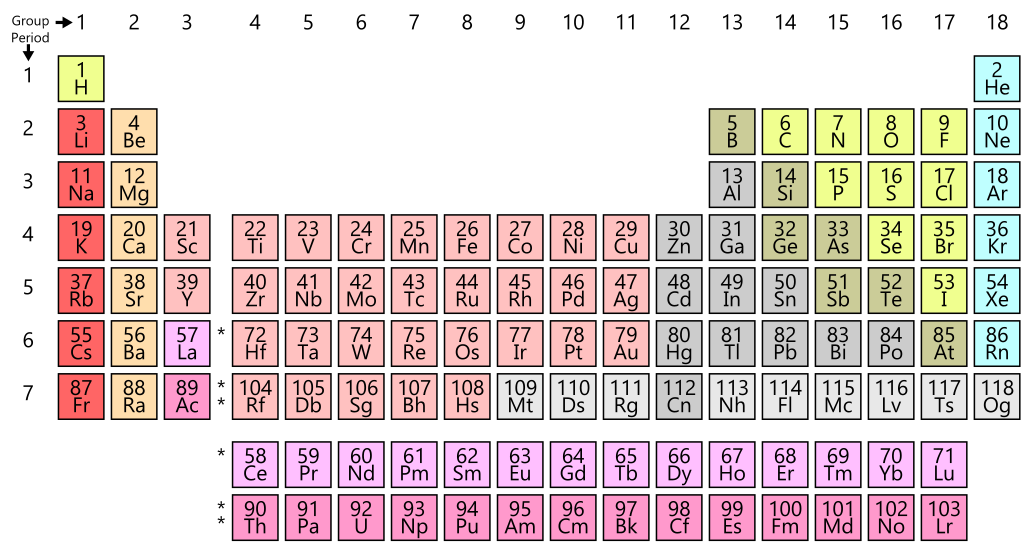A Brief Interlude: A Crash Course in Basic Chemistry
Last week ended with a brief mention of cation exchange being the activity that occurs on the very large surface areas of clay and humus colloids. But before we get to cation exchange, first some very simple chemistry to get up to speed on what a cation actually is.
An atom is the smallest non-divisible particle of an element. All elements are listed in the Periodic Table by a one or two letter combination unique to them:
Examples of elements are hydrogen (H), oxygen (O), magnesium (Mg) and zinc (Zn). Some letter combinations aren’t intuitive, such as Fe for iron and Pb for lead. [Those invariably come from Latin words, eg ferrum for iron (from which we get ‘ferrous’) and plumbum for lead (from which we get ‘plumb’ as in plumbing (lead pipes!) and ‘plumb bob’ (a weight of lead)).]
Atoms are made up of protons, neutrons and electrons. A proton is positively charged with a charge of +1. A neutron has no charge (it’s neutral), and an electron is negatively charged with a charge of -1.
The atoms of each element always have the same number of protons — in fact it’s the number of protons that determines the element — and that number of protons matches the number in the Periodic Table. For example, every single hydrogen (H) atom always has one proton, and every single carbon (C ) atom always has six protons in its nucleus. Any atom with thirteen protons is always an aluminium (Al) atom. And so on.
An atom has the same number of electrons as protons, giving it a net neutral charge.
Should an atom gain or lose electrons, it becomes an ion, or an atom with a charge. In other words, in gaining or losing one or more electrons it becomes negatively- or positively-charged respectively.
If an atom loses an electron(s) it has a net positive charge and is called a positive ion, or cation (CAT-eye-on, but said more quickly than this spelling suggests). A cation is an ion that goes to the cathode, the negatively charged electrode in electrolysis, hence the name. A hydrogen atom loses one electron to become a hydrogen cation with a net charge of +1, written as H+. A zinc atom loses two electrons to become a Zn2+ cation.
If an atom gains an electron(s) it has a net negative charge and is called a negative ion, or anion (AN-eye-on, again said quickly). An anion is the ion that goes to the anode, or the positively charged electrode in electrolysis. A chlorine atom loses one electron to become a chlorine anion (it’s more correct to say chloride when referring to the ion, ie chloride ion) with a net charge of -1, written as Cl-. An oxygen atom gains two electrons to become an O2- anion.
When an atom loses or gains an electron(s) to become a charged ion, it becomes active and can participate in reactions.
We’ve seen how the clay and humus particles (colloids) in soil have very large surface areas, which are negatively-charged. Cations, being positively-charged, are attracted to these surfaces. The cations are usually held loosely by the colloids, and often exchange places with other cations nearby in the soil water — hence they are exchangeable cations.
Next week we shall discuss the role of exchangeable cations in soil, and why their presence matters.
About the Author
BSc(Hons), U.Syd. - double major in biochemistry and microbiology, with honours in microbiology
PhD, U.Syd - soil microbiology
Stumbled into IT and publishing of all things.
Discovered jujube trees and realised that perhaps I should have been an agronomist...
So I combined all the above passions and interests into this website and its blog and manuals, on which I write about botany, soil chemistry, soil microbiology and biochemistry - and yes, jujubes too!
Please help me buy a plant if you found this article interesting or useful!
2 comments
Comment from: karenvsandon Member
Comment from: kristi Member

Thank you so much! I do worry that sometimes I might be writing with too much presumed knowledge, so please don’t hesitate to let me know if something needs more explanation!
best regards,
Kristi

Hi. I am absolutely loving reading this blog! My high school chemistry is coming back and I am extremely interested to learn more!